Norwegian Air Shuttle Bundle
How did Norwegian Air Shuttle reshape the aviation landscape?
Embark on a journey through the Norwegian Air Shuttle SWOT Analysis to uncover the remarkable transformation of Norwegian Air Shuttle, a company that redefined low-cost air travel. From its humble beginnings as a regional carrier, Norwegian Air Shuttle, also known as Norwegian Air, has soared to become a major player in the global airline industry. Discover the key milestones and strategic decisions that propelled this Scandinavian airline to international prominence.
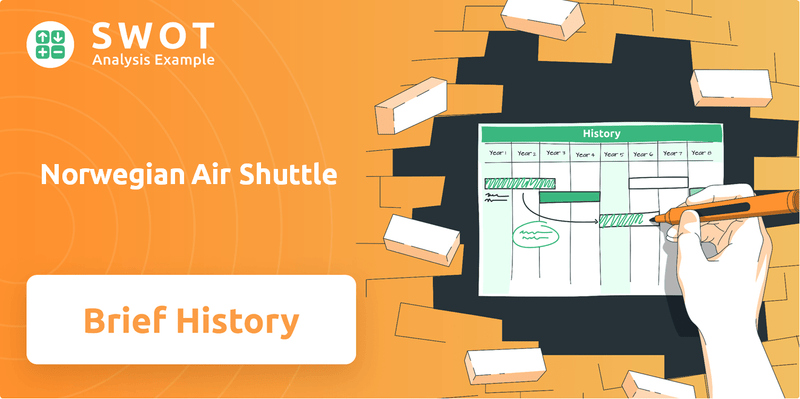
The Norwegian history is a compelling narrative of strategic adaptation and ambitious growth. Founded on January 22, 1993, the Norwegian airline initially focused on domestic routes within Scandinavia before expanding its reach across Europe and beyond. Its evolution from a regional operator to a significant European low-cost carrier showcases its resilience, innovation, and unwavering commitment to its founding vision, making it a fascinating case study in airline history.
What is the Norwegian Air Shuttle Founding Story?
The founding of Norwegian Air Shuttle, a key player in Scandinavian airlines history, took place on January 22, 1993. This marked the beginning of a journey that would see the airline transform from a regional operator to a significant low-cost carrier. The initial goal was to take over regional flight operations previously managed by Busy Bee for Braathens in Western Norway.
The company was established by former Busy Bee employees, starting with a workforce of around fifty individuals. Based initially in Bergen, Norwegian Air Shuttle quickly established a technical base in Stavanger. The primary objective was to continue regional flight services after Busy Bee faced bankruptcy in December 1992. This strategic move allowed Norwegian to step in and take over operations, using three leased Fokker 50 aircraft.
The early business model centered on operating regional routes, such as Bergen to Haugesund, and Bergen to Molde or Kristiansund, with onward connections to Trondheim. The company's success in its early years was driven by offering low-cost tickets, a strategy that set it apart from other airlines in the region. The shift to a low-cost carrier model in 2002, along with the transition from Fokker 50s to Boeing 737s, was a pivotal moment in the Norwegian history. The Marketing Strategy of Norwegian Air Shuttle played a crucial role in its expansion.
Norwegian Air Shuttle's early operations focused on regional routes, capitalizing on the need for continued service after Busy Bee's bankruptcy. The company's initial fleet consisted of leased Fokker 50 aircraft.
- The company's formation was driven by former Busy Bee employees.
- The original business model focused on regional routes, offering low-cost tickets.
- A key strategic shift occurred in 2002, transitioning to a low-cost carrier model.
- The transition to Boeing 737s marked a significant change in fleet and operations.
Norwegian Air Shuttle SWOT Analysis
- Complete SWOT Breakdown
- Fully Customizable
- Editable in Excel & Word
- Professional Formatting
- Investor-Ready Format
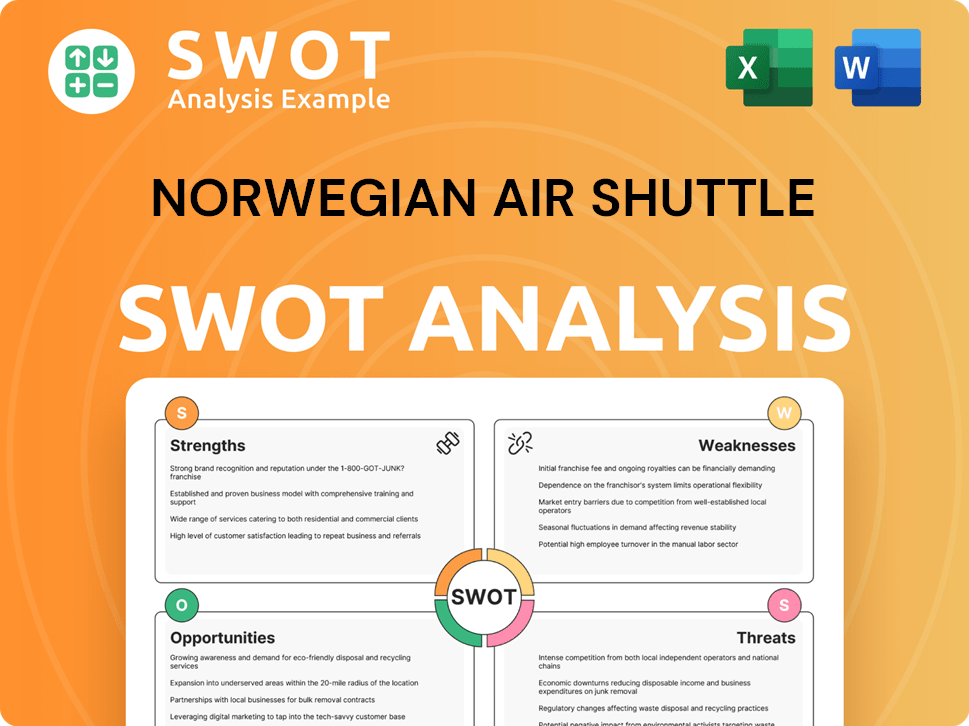
What Drove the Early Growth of Norwegian Air Shuttle?
The early years of Norwegian Air Shuttle, or Norwegian Air, focused on establishing itself within Norway's regional flight market. This period, marked by strategic decisions and fleet expansions, laid the groundwork for its transformation. Key milestones included fleet growth, financial achievements, and pivotal shifts in business models that defined the airline's trajectory.
Initially,
A significant strategic change occurred in August 2002 when Norwegian Air Shuttle repositioned itself as a low-cost airline. This involved a switch from Fokker 50s to Boeing 737 aircraft. On September 1, 2002, the airline launched its first low-cost routes from Oslo to Bergen, Trondheim, Stavanger, and Tromsø, utilizing six Boeing 737-300s.
The company expanded its operations by establishing a base at Arlanda, Sweden, in 2007, and entering the Danish market with a Copenhagen base in 2008. In July 2010, Norwegian Air Shuttle initiated flights from Oslo-Gardermoen and Stockholm to Helsinki-Vantaa Airport. The airline rapidly expanded its fleet, taking delivery of its first Boeing 737-800 Next-Generation aircraft in January 2008.
By the end of 2012, Norwegian Air Shuttle operated 68 aircraft, increasing to 85 by the end of 2013. In January 2012, the airline placed a major order for 222 aircraft, including 100 Boeing 737 MAX 8s, 22 Boeing 737-800s, and 100 Airbus A320neos. This was Europe's largest single aircraft order at the time. This period saw strong double-digit passenger growth rates, particularly in Oslo and the Nordic region, and a growing proportion of revenue from ancillary services.
Norwegian Air Shuttle PESTLE Analysis
- Covers All 6 PESTLE Categories
- No Research Needed – Save Hours of Work
- Built by Experts, Trusted by Consultants
- Instant Download, Ready to Use
- 100% Editable, Fully Customizable
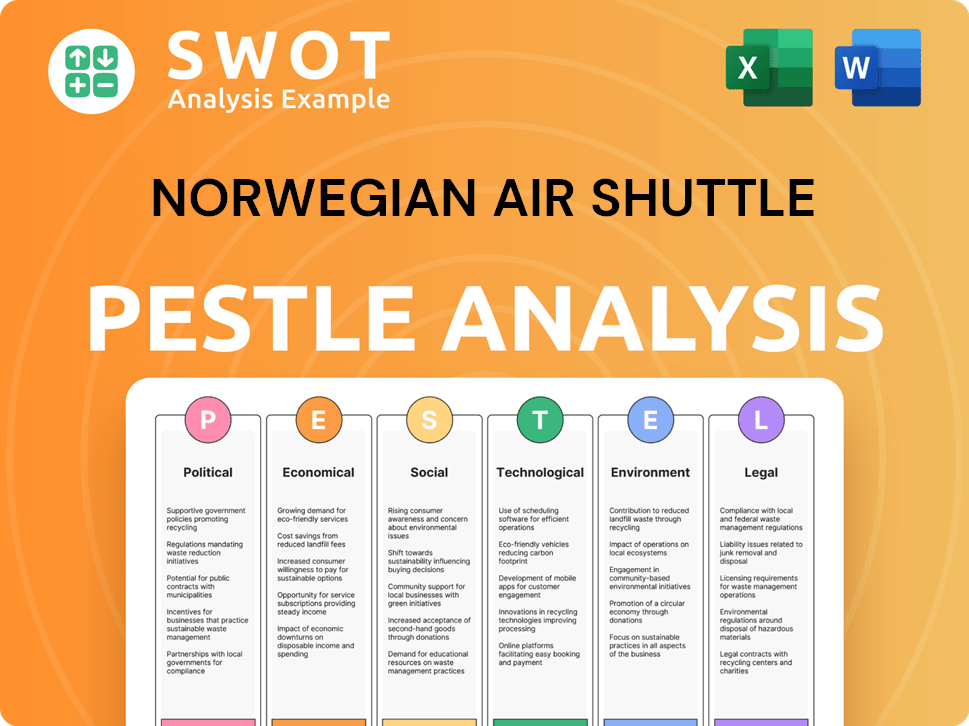
What are the key Milestones in Norwegian Air Shuttle history?
The Norwegian Air Shuttle has achieved significant milestones in its journey, demonstrating resilience and adaptability within the competitive airline industry. These achievements highlight its evolution and strategic responses to market dynamics.
| Year | Milestone |
|---|---|
| Early 2000s | Launched as a low-cost carrier, quickly establishing itself in the Scandinavian market. |
| 2013 | Expanded its operations with long-haul flights, targeting the transatlantic market. |
| 2018 | Recognized as the most fuel-efficient airline on transatlantic routes by The International Council on Clean Transportation (ICCT). |
| 2021 | Restructured its operations, focusing on its core short-haul European network after facing financial difficulties. |
| January 2024 | Acquired Widerøe, boosting passenger numbers and market share in Norway. |
| December 2024 | Secured a legal victory regarding EU ETS obligations, potentially alleviating a NOK 400 million penalty. |
One of the key innovations for the Norwegian airline was being among the first to offer free Wi-Fi on European routes, significantly enhancing the passenger experience. The company has also focused on sustainability, operating a modern and fuel-efficient fleet to reduce carbon emissions, with recognition in 2024 for its commitment to sustainable aviation fuel.
Offering free Wi-Fi on European routes was a significant step in enhancing customer experience.
Operating a modern, fuel-efficient fleet is a key part of the company's sustainability efforts.
Recognized in 2024 for its commitment to sustainable aviation fuel.
The Norwegian airline has faced considerable challenges, including significant restructuring between 2018 and 2021 due to aggressive growth and the COVID-19 pandemic's impact. Financial hurdles, such as currency fluctuations, have also affected operating profit, with the weakening of the Norwegian Krone against the US Dollar impacting the bottom line in 2024.
Aggressive growth and costs associated with new routes and aircraft led to significant financial strain.
The pandemic caused a dramatic downturn in travel demand, necessitating government aid and fleet reductions.
The weakening of the Norwegian Krone against the US Dollar negatively impacted operating profit in 2024.
Norwegian Air Shuttle Business Model Canvas
- Complete 9-Block Business Model Canvas
- Effortlessly Communicate Your Business Strategy
- Investor-Ready BMC Format
- 100% Editable and Customizable
- Clear and Structured Layout
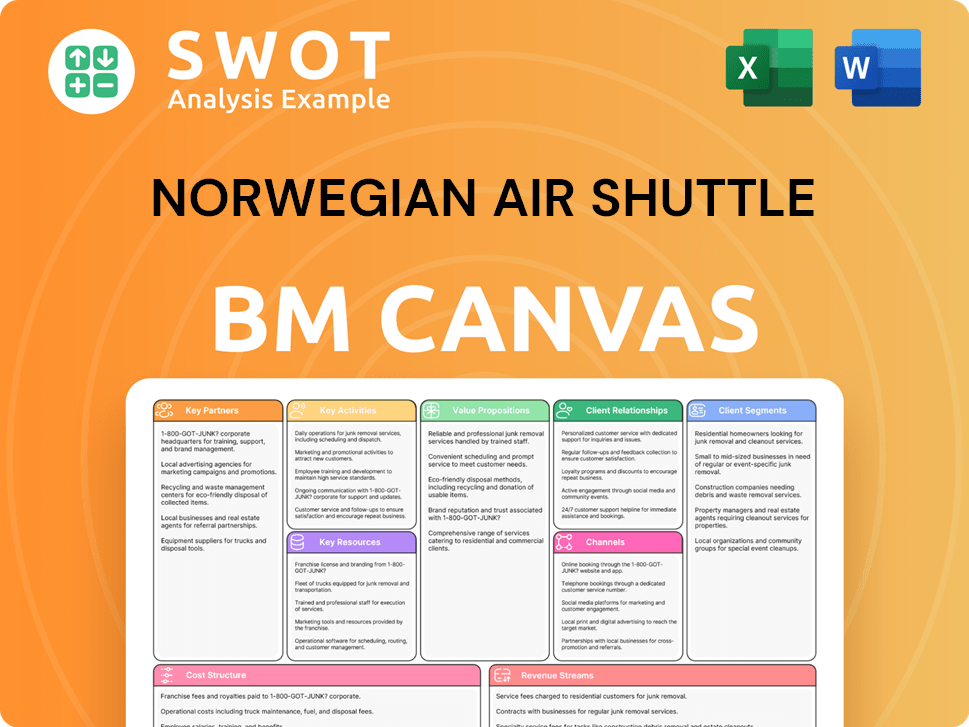
What is the Timeline of Key Events for Norwegian Air Shuttle?
The Norwegian Air Shuttle has a rich history, evolving from a regional airline to a major low-cost carrier. Here's a look at some key milestones.
| Year | Key Event |
|---|---|
| January 22, 1993 | Norwegian Air Shuttle (NAS) was founded to take over regional airline services. |
| 1995 | Revenue reached NOK 86.6 million, with a profit of NOK 2.9 million. |
| August 2002 | The airline repositioned itself as a low-cost carrier, using Boeing 737 aircraft. |
| September 1, 2002 | Launched its initial low-cost routes from Oslo. |
| December 18, 2003 | Listed on the Oslo Stock Exchange. |
| 2007 | Bank Norwegian and the frequent flyer program Norwegian Reward were launched, and a base was established in Arlanda, Stockholm. |
| January 2008 | The first Boeing 737-800 Next-Generation aircraft was delivered, and a base opened in Copenhagen. |
| January 2012 | Placed the largest single aircraft order in Europe, for 222 Boeing and Airbus aircraft. |
| 2013 | Launched long-haul routes to New York and Bangkok. |
| 2018-2021 | Underwent significant restructuring, including fleet reduction and the closure of long-haul operations due to the COVID-19 pandemic. |
| 2020 | Committed to reducing CO2 emissions by 45% by 2030. |
| January 2024 | Completed the acquisition of Widerøe, strengthening its domestic and regional network. |
| December 2024 | Extended partnership with Lufthansa Technik for base maintenance services for five years, starting August 1, 2025. |
| December 2024 | Achieved a legal victory regarding EU ETS obligations, potentially recovering NOK 400 million. |
| Q4 2024 | Reported a full-year operating profit (EBIT) of NOK 1,873 million, the second highest in company history, despite a negative EBIT of NOK 93 million in Q4 due to currency fluctuations, with total operating revenue for the full year 2024 reaching NOK 35,317 million. |
| Q1 2025 | Acquired 10 Boeing 737-800 aircraft previously on lease, recognizing a non-recurring gain of NOK 589 million. The fleet comprised 89 aircraft at quarter-end, with 25 being 737 MAX 8 aircraft. |
The airline plans to increase its capacity into the summer 2025 season. The forecast for the year anticipates a low single-digit growth in production, approximately 3%. The company is focused on expanding its services.
By the end of 2025, the fleet is expected to grow to 94-96 aircraft. The airline anticipates receiving 11 to 13 aircraft deliveries during the year. This expansion supports the company's growth plans.
The company is concentrating on reducing costs and leveraging synergies from its acquisition of Widerøe. The 'Program X' profitability program aims to generate over NOK 1 billion in recurring underlying profit improvement by the end of 2026.
A decision will be made by autumn 2025 regarding the exercise of 30 options for Boeing 737-8 MAX aircraft. The company's strategic focus remains on disciplined growth and profitability.
Norwegian Air Shuttle Porter's Five Forces Analysis
- Covers All 5 Competitive Forces in Detail
- Structured for Consultants, Students, and Founders
- 100% Editable in Microsoft Word & Excel
- Instant Digital Download – Use Immediately
- Compatible with Mac & PC – Fully Unlocked
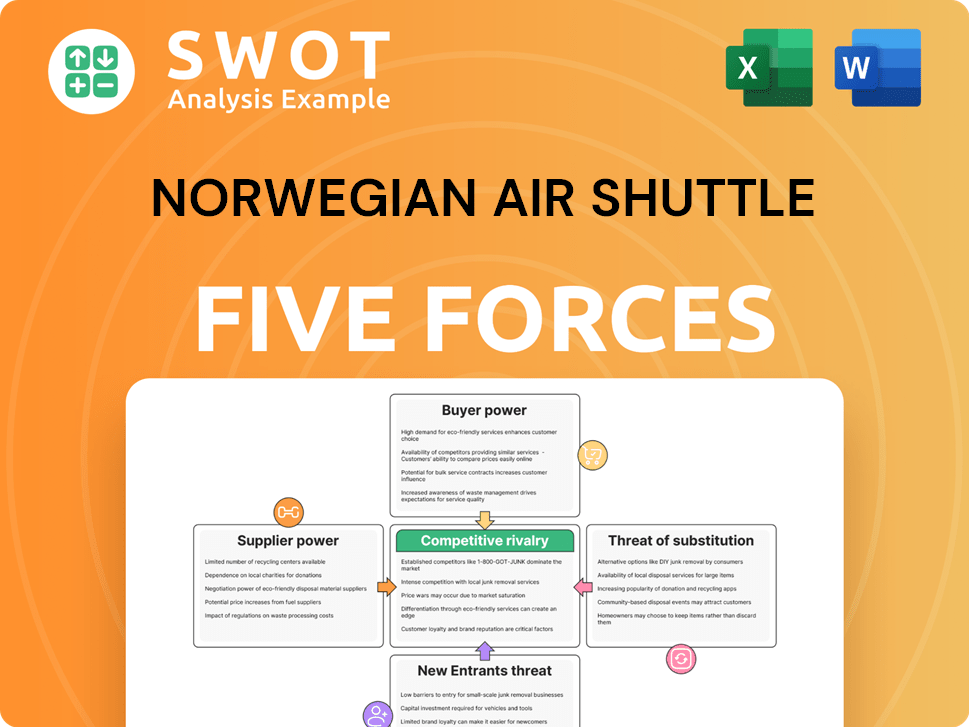
Related Blogs
- What is Competitive Landscape of Norwegian Air Shuttle Company?
- What is Growth Strategy and Future Prospects of Norwegian Air Shuttle Company?
- How Does Norwegian Air Shuttle Company Work?
- What is Sales and Marketing Strategy of Norwegian Air Shuttle Company?
- What is Brief History of Norwegian Air Shuttle Company?
- Who Owns Norwegian Air Shuttle Company?
- What is Customer Demographics and Target Market of Norwegian Air Shuttle Company?
Disclaimer
All information, articles, and product details provided on this website are for general informational and educational purposes only. We do not claim any ownership over, nor do we intend to infringe upon, any trademarks, copyrights, logos, brand names, or other intellectual property mentioned or depicted on this site. Such intellectual property remains the property of its respective owners, and any references here are made solely for identification or informational purposes, without implying any affiliation, endorsement, or partnership.
We make no representations or warranties, express or implied, regarding the accuracy, completeness, or suitability of any content or products presented. Nothing on this website should be construed as legal, tax, investment, financial, medical, or other professional advice. In addition, no part of this site—including articles or product references—constitutes a solicitation, recommendation, endorsement, advertisement, or offer to buy or sell any securities, franchises, or other financial instruments, particularly in jurisdictions where such activity would be unlawful.
All content is of a general nature and may not address the specific circumstances of any individual or entity. It is not a substitute for professional advice or services. Any actions you take based on the information provided here are strictly at your own risk. You accept full responsibility for any decisions or outcomes arising from your use of this website and agree to release us from any liability in connection with your use of, or reliance upon, the content or products found herein.